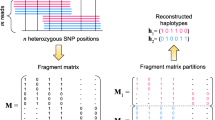Abstract
Single nucleotide polymorphism (SNP) in human genomes is considered to be highly associated with complex genetic diseases. As a consequence, obtaining all SNPs from human populations is one of the primary goals of recent studies on human genomics. The two sequences of SNPs in diploid human organisms are called haplotypes. In this paper, the problem of haplotype reconstruction from SNP fragments with and without genotype information is studied. Minimum error correction (MEC) is an important model for this problem but only effective when the error rate of the fragments is low. MEC/GI, as an extension to MEC model, employs the related genotype information besides the SNP fragments and, therefore, results in a more accurate inference. We introduce algorithmic neural network-based approaches and experimentally prove that our methods are fast and accurate. Particularly, our approach is faster, more accurate, and also compatible for solving MEC model, in comparison with a feed-forward (and back propagation like) neural network.






Similar content being viewed by others
Explore related subjects
Discover the latest articles, news and stories from top researchers in related subjects.References
Zhang X, Wang R, Wu L, Zhang W (2006) Minimum conflict individual haplotyping from SNP fragments and related Genotype. Evol Bioinformatics 2:271–280
Venter JC, Adams MD et al (2001) The sequence of the human genome. Science 291(5507):1304–1351
Terwilliger J, Weiss K (1988) Linkage disequilibrium mapping of complex disease: fantasy and reality? Curr Opin Biotechnol 9:579–594
Chakravarti A It’s raining, hallelujah? Nat Genet 19:216–217
Wang R, Wu L, Li Z, Zhang X (2005) Haplotype reconstruction from SNP fragments by minimum error correction. Bioinformatics 21(10):2456–2462
Bonizzoni P, Vedova GD, Dondi R, Li J (2003) The haplotyping problem: an overview of computational models and solutions. J Comput Sci Technol 18(6):675–688
Gusfield D (2001) Inference of haplotypes from samples of diploid populations: complexity and algorithms. J Comput Biol 8(3):305–323
Gusfield D (2002) Haplotyping as perfect phylogeny: conceptual framework and efficient solution. In: Proceedings of the sixth annual international conference on computational biology. ACM Press, New York, pp 166–175
Wang LS, Xu Y (2003) Haploptye inference by maximum parsimony. Oxford J Bioinform 19(14):1773–1780
Yuzhong Zh, Xu-Yun, Qiangfeng Zh, Guoliang Ch (2007) An overview of the haplotype problems and algorithms, 3rd edn, vol 1. Frontiers of Computer Science in China, Higher Education Press, Springer GmbH, pp 272–282
Zhang XS, Rui-Sh W, Wu L, Ling Y, Chen L (2006) Models and algorithms for haplotyping problem. Curr Bioinformatics 1(1):105–114
Marchini J, Cutler D, Patterson N, Stephens M, Eskin E, Halperin E, Lin S, Qin ZS, Munro HM, Abecasis GR, Donnelly P, International HapMap Consortium (2006) a comparison of phasing algorithms for trios and unrelated individuals. Am J Human Genet 78:437–450. (http://www.stats.ox.ac.uk/~marchini/phaseoff.html)
Patil N, Berno AJ, Hinds DA et al (2001) Blocks of limited haplotype diversity revealed by high-resolution scanning of human chromosome 21. Science 294(5547):1719–1723
Daly MJ, Rioux JD, Schaffner SF et al (2001) High-resolution haplotype structure in the human genome. Nat Genet 29:229–232
Gabriel SB, Schaffner SF, Nguyen H et al (2002) The structure of haplotype blocks in the human genome. Science 296(5576):2225–2229
Panconesi A, Sozio M (2004) Fast hare: a fast heuristic for single individual SNP haplotype reconstruction. In: Proceedings of 4th workshop on algorithms in bioinformatics (WABI), LNCS Springer, pp 266–277
Greenberg HJ, Hart EW, Lancia G (2004) Opportunities for combinatorial optimization in computational biology. INFORMS J Comput 16(3):211–231
Asgarian E et al (2008) Solving haplotype reconstruction problem in MEC model with hybrid information fusion, European symposium on computer modelling and simulation
Moeinzadeh M-H, Asgarian E et al (2007) Three heuristic clustering methods for haplotype reconstruction problem with genotype information, international conference on innovations in information technology
Rieder M, Taylor S, Clark A, Nickerson D (1999) Sequence variation in the human angiotensin converting enzyme. Nat Genet 22:59–62
Author information
Authors and Affiliations
Corresponding author
Rights and permissions
About this article
Cite this article
Moeinzadeh, MH., Asgarian, E. & Sharifian-R, S. Neural network-based approaches, solving haplotype reconstruction in MEC and MEC/GI models. Neural Comput & Applic 22, 1397–1405 (2013). https://doi.org/10.1007/s00521-012-0961-y
Received:
Accepted:
Published:
Issue Date:
DOI: https://doi.org/10.1007/s00521-012-0961-y




